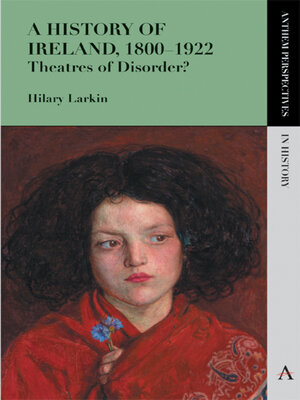A History of Ireland, 1800–1922
ebook ∣ Theatres of Disorder? · Anthem Perspectives In History
By Hilary Larkin

Sign up to save your library
With an OverDrive account, you can save your favorite libraries for at-a-glance information about availability. Find out more about OverDrive accounts.
Find this title in Libby, the library reading app by OverDrive.



Search for a digital library with this title
Title found at these libraries:
| Library Name | Distance |
|---|---|
| Loading... |
The years of Ireland's union with Great Britain are most often regarded as a period of great turbulence and conflict. And so they were. But there are other stories too, and these need to be integrated in any account of the period. Ireland's progressive primary education system is examined here alongside the Famine; the growth of a happily middle-class Victorian suburbia is taken into account as well as the appalling Dublin slum statistics. In each case, neither story stands without the other.
This study synthesises some of the main scholarly developments in Irish and British historiography and seeks to provide an updated and fuller understanding of the debates surrounding nineteenth- and early twentieth-century history.
|There is no lack of sensationalism in the period of Irish history 1800–1922. Large dramas played themselves out in small places. The last subsistence crisis of Europe would be enough to justify this judgement, but there is more: endemic levels of violence, the formation of the first state police force in the history of Britain, republican militancy, tithe and land wars, socialist protest, armed insurrection, war and civil war pockmark the era. The history of Ireland, particularly in its relationship to the imperial power of Britain, has been fraught to say the least. The so-called 'Pax Britannica' never became a genuine 'Pax Hibernia'.
However, such an account needs to be balanced against other stories that emerge from the period. Ireland had its own 'Victorian' era and a more benign revolution in social mores, technology, communication and transport. Many features of twentieth-century political and social practice were then established: a system of public health, factory inspection, primary education, ordnance survey mapping, civic improvement and census taking. Sporting, musical and cultural traditions knew an intense phase of development. Moreover, Irish leaders and many of the middle-classes adapted to the Union's constitutional arrangements and successfully exploited it to their advantage. In 1922, both north and south Ireland did inherit a certain institutional stability from the Union era.
Both of these stories need to be told together to reflect the recent scholarship on all areas of modern Irish history. This book is a historiographical synthesis, providing readers with an understanding of the nature of current arguments and debates about a past that is neither dead nor, in many ways, even past.







